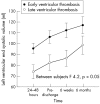Relation between early mitral regurgitation and left ventricular thrombus formation after acute myocardial infarction: results of the GISSI-3 echo substudy
- PMID: 12117831
- PMCID: PMC1767209
- DOI: 10.1136/heart.88.2.131
Relation between early mitral regurgitation and left ventricular thrombus formation after acute myocardial infarction: results of the GISSI-3 echo substudy
Abstract
Objective: To evaluate the prevalence and correlates of left ventricular thrombosis in patients with acute myocardial infarction, and whether the occurrence of early mitral regurgitation has a protective effect against the formation of left ventricular thrombus.
Design and setting: Multicentre clinical trial carried out in 47 Italian coronary care units.
Patients and methods: 757 patients from the GISSI-3 echo substudy population with their first acute myocardial infarct were studied by echocardiography at 24-48 hours from symptom onset (S1), at discharge (S2), at six weeks (S3), and at six months (S4). The diagnosis of left ventricular thrombosis was based on the detection of an echo dense mass with defined margins visible throughout the cardiac cycle in at least two orthogonal views.
Results: In 64 patients (8%), left ventricular thrombosis was detected in one or more examinations. Compared with the remaining 693 patients, subjects with left ventricular thrombosis were older (mean (SD) age: 64.6 (13.0) v 59.8 (11.7) years, p < 0.005), and had larger infarcts (extent of wall motion asynergy: 40.9 (11.5)% v 24.9 (14)%, p < 0.001), greater depression of left ventricular ejection fraction at S1 (43.3 (6.9)% v 48.1 (6.8)%, p < 0.001), and greater left ventricular volumes at S1 (end diastolic volume: 87 (22) v 78 (18) ml/m(2), p < 0.001; end systolic volume: 50 (17) v 41 (14) ml/m(2), p < 0.001). The prevalence of moderate to severe mitral regurgitation on colour Doppler at S1 was greater in patients who had left ventricular thrombosis at any time (10.2% v 4.2%, p < 0.05). On stepwise multiple logistic regression analysis the only independent variables related to the presence of left ventricular thrombosis were the extent of wall motion asynergy and anterior site of infarction.
Conclusions: Left ventricular thrombosis is not reduced, and may even be increased, by early moderate to severe mitral regurgitation after acute myocardial infarction. The only independent determinant of left ventricular thrombosis is the extent of the akinetic-dyskinetic area detected on echocardiography between 24-48 hours from symptom onset.
Figures
References
-
- Jordan RA, Miller RD, Edwards JE, et al. Thrombo-embolism in acute and healed myocardial infarction. I. Intracardiac mural thrombosis. Circulation 1952;6:1–6. - PubMed
-
- Asinger RW, Mikell FL, Elsperger J, et al. Incidence of left ventricular thrombosis after acute transmural myocardial infarction. N Engl J Med 1981;305:297–302. - PubMed
-
- Keating EC, Gross SA, Schlamowitz RA. Mural thrombi in myocardial infarction: prospective evaluation by two-dimensional echocardiography. Am J Med 1983;74:989–95. - PubMed
-
- Stratton JR. Mural thrombi of the left ventricle. Chest 1983;83:166–8. - PubMed
Publication types
MeSH terms
LinkOut - more resources
Full Text Sources
Medical


